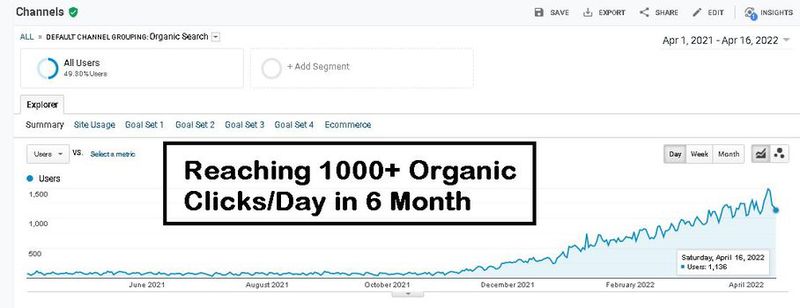SEO + Content Case Study

We did an SEO experiment that has blown our minds away.
Website Type – Business Website
Business Model – B2B & B2C
Target Country – United States & Canada
Conclusion – Rise in Impressions is directly proportional to Rising Authority in Google. I.e. with rising impressions, the website authority rises.
Tools We Used – Ahrefs, SEMRush, Keywordtool.io, Cora SEO, Surfer SEO, Google Analytics, Google Search Console, SERP Robot.
I will try to provide as much detail as possible to make it clear at the conceptual level.
—— Let’s Begin—–
We have a thin content website in hand in October 2021. A website with around 50 average organic traffic per day, not strong brand searches, few backlinks, and a lot of clients’ expectations. We had a 1000 clicks per day organic traffic goal to achieve in the next 6 months.
Here is how we achieved the desired traffic goals.
I first break down the entire process for you into 3 key processes.
-
Keywords Research, Keyword grouping, and keyword funneling.
-
Content
-
On page
KEYWORDS RESEARCH AND KEYWORD GROUPING
We did keywords research and funneled the keywords based on searcher intent and sales funnel. After that, We had our lists of transactional, navigational, informational, decision making, and geo-targeted keywords.
When we analyzed the keywords in Ahrefs, All odds were against us. You can see in the attachments High keyword difficulty keywords. 40 was the minimum KD we saw.
Next, we immediately planned to start producing content.
Before jumping to content. We did a second layer of keyword grouping to make sure we don’t produce any waste content during the process that does not generate impressions for us.
THE CONTENT
The content was the major part of this strategy. But unlike other content strategies, Instead of targetting transactional keywords like buying something, or buy something online or best something in Los Angeles.
 The biggest risk we took.
The biggest risk we took.
We started with navigational keywords . Our content team came up with a series of content ideas that had the potential to rank on navigational branded keywords.
. Our content team came up with a series of content ideas that had the potential to rank on navigational branded keywords.
With On-page optimization, in-depth internal linking we published roughly around 100 blogs in 3 months with an average length of 1500 words per article all targeting different brands.
Right from week 1, we started to see a huge impression jump, and by the end of 1 month, we started to get clicks only.
Once we had consistent organic impression growth in the google search console. But most of them were navigational brand keywords.
we start producing content on transactional keywords next and as soon as we start publishing, We could easily see that our published navigational blogs have already set some domain authority in google, and because of this our new articles were indexed in the top 50 from the very first day of discovery.
In Total, we published 250 blogs so far and every single blog is contributing impressions. So far we reached nearly 1000 clicks/day but we are all ready to cross 2000 clicks/day in the next 4 months. With a lot of high-volume keywords rankings on page 2.
There are a few other off-page and technical SEO things involved but I think content and keyword targeting play a major role in the strategy to perform well.
I hope you will find it useful. And This small case study gave you another perspective to see domain authority beyond tools.
This is the motivation for taking a scientific SEO approach. It’s been 2 years of being part of SEO community.
Few comments from readers:
The scientific method of seeing what works for each client individual and uniquely has tremendous value in a world of magic tracks and jargon that don’t work or move the needle.
What you have demonstrated here is proof of strategy. You hypothesize then test then provide empirical data. My case study for surfer 4 years ago was very similar and it just makes sense. Starting with intent then topical authority and staying within your fighting weight and level up when the SERP allows it.
It has very little to do with authority (this is a fictitious number used by tools)and backlinks as you discovered and technical SEO that has no correlation with conversion or clicks doesn’t move the needle much it’s a long game.
QDF query deserves freshness you proved that.
This process is a bit accelerated at 100 articles and a bit unnatural so expect some shaking up.
Keep in mind each article will go through cycles of relevance of each keyword branded, short and long tail as well as who,what,where,when and why.
You will see fluctuations you will see corrections you will have drop offs and rebounds. Expect that!. So I’ll add to your process.
Revisit these posts with the content auditor and optimize within three months. Schedule it. Part two assess your donkey posts that aren’t moving or driving ROI. Can you combine and prune posts?
If so do that. Turn your donkeys into champions then turn the champions into unicorns. Expect out of 100 posts maybe 1 to 10 to really drive 90 percent of the organic traffic. And last but not least don’t lose focus of your site visitors because when you think like a site visitor you think like a search engine.
Great job! and yeah maybe you didn’t price out your service as you should great things always have small beginnings, what’s important here all together is that you are learning in order to succeed in SEO is to think of the clients business metrics and adapt your strategy to their goals with the success metrics that matter and to bring in quick wins. Revenue over Rankings!








